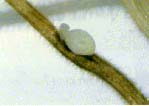|
Contact the Extension office at (217)
732-8289 to make a reservation, and you will receive more detailed
information about the program.

[photos courtesy of John Fulton]
Soybean cyst nematode clinic
In order to help producers determine
levels of infestation with soybean cyst nematode, a soil evaluation
clinic is scheduled for March 5 from 9 to 11 a.m. at the Extension
office. The clinic will focus on soil analysis of samples brought in
by clientele.
Producers may submit up to two samples
for free analysis. Additional samples will cost $5 each. Samples
should be taken like soil fertility samples: depth of 6-7 inches,
subsamples pulled from field, and enough final sample to fill half
of a small lunch bag. If you are unsure of how to break down fields,
I would recommend that you submit samples for areas that you are
willing to manage separately. This means acreage blocks that you are
willing to plant resistant varieties on.

Please feel free to contact the
Extension office at 732-8289 with any questions that you might have.
[to top of second column in
this article]
|

Certification for private pesticide applicators
Logan County has now completed its
second and final clinic for the year for private pesticide
applicators. Those still needing to attend a clinic have just a few
options left for this year:
Feb. 25 -- Tazewell County, ICC Lecture
Hall, 1 p.m.; training and testing
Feb. 26 -- Cass County, St. Luke Hall,
1 p.m.; training and testing
March 4 -- Macon County, Extension
office, 6 p.m.; training and testing
March 7 -- Menard County, Extension
office, 10 a.m.; testing only
March 10 -- DeWitt County, Farmer City,
6 p.m.; training and testing
The only
other option is to make an appointment, drive to Springfield and
take the exam at the Illinois Department of Agriculture. Call
(217)785-2427 for an appointment. The last word was that they were
backed up about a month on appointments.

[John
Fulton]
|
|
The top yielding county in the state
for both corn and soybean averages was Carroll County, with an
average corn yield of 179 bushels per acre and an average soybean
yield of 57 bushels per acre. Other counties with high corn yields
were Rock Island with 176, Mercer and Warren with 175, Knox with
170, and Henry with 169. Other counties with high soybean yields
were Champaign and McLean with 54; Henry, JoDaviess, Rock Island,
and Woodford with 53; and Logan, DeWitt, Iroquois, Piatt, Stark,
Tazewell and Warren with 52.
The top producing counties, in terms of
bushels, were McLean County for soybeans with 16,259,400 bushels of
soybeans and Iroquois County with 49,027,400 bushels of corn. Logan
County production was 8,320,000 bushels of soybeans and 28,043,400
bushels of corn.
The Logan County five-year average
yields are 155 for corn and 49 bushels for soybeans. These figures
are averages from 1998 to 2002.

[to top of second column in
this article]
|

Following is a table of yields in 2002
from Logan and surrounding counties:
| County |
2002 corn yield (bu/A) |
2002 soybean
yield (bu/A) |
| Logan |
154 |
52 |
| Sangamon |
153 |
51 |
| Menard |
155 |
48 |
| Mason |
140 |
47 |
| Tazewell |
151 |
52 |
| McLean |
145 |
54 |
| DeWitt |
134 |
52 |
| Macon |
134 |
49 |
| Christian |
140 |
49 |
| State average |
136 |
43 |
This has been another in a series of
unusual years. Late rains really helped soybean yields, while corn
was already shutting down when the rains came in August. The most
deciding factors in corn yields were the lack of rainfall during
July and the very high temperatures experienced from July through
early August.
[John
Fulton]
|
|
"Seasonally, we are approaching the
time frame when prospects for the 2003 U.S. crop may determine the
fate of prices -- a point made in recent weeks and one that is
underscored by prospects of small stocks and some early concerns
about soil moisture conditions," said Darrel Good. "Everything seems
to be pointing to more volatile prices over the next few months."
Good noted that trading ranges to date
have been relatively narrow. December 2003 corn futures have had a
trading range of only 34 cents. The smallest range in the previous
32 years was 54 cents in 1987. Similarly, November 2003 soybean
futures have had a trading range of 90 cents. In the previous 30
years, the trading range was less than $1.15 only once -- 91 cents
for the 1986 contract.
"Since Sept. 1, 2002, the trading
ranges for the average cash price of corn and soybeans in central
Illinois have been $0.575 and $0.885, respectively," said Good. "In
the previous 30 years, the trading range for cash corn prices during
the 12-month marketing year was $0.575 or less only three times. The
trading range for cash soybean prices was less than $1 only twice."
It appears, Good said, that the trading
ranges for spot cash prices in the current marketing year, and for
new crop futures in particular, will be expanded.
"The more difficult question is, in
which direction?" he said. "Given that December 2003 corn futures
have traded to a high of only $2.69 and November 2003 futures have
traded to a high of only $5.43, it appears likely that the trading
range of those contracts will be expanded to the upside.
"It is a tougher call for old crop
prices, but new highs in the cash soybean market have a high
probability. It will be difficult for cash corn prices to exceed the
early September 2002 highs."
Good's comments came as he reviewed
recent actions in the corn and soybean markets. Prices for both
commodities have recovered most of the declines experienced in
mid-January.
The average cash price of corn in
central Illinois declined from $2.39 on Jan. 8 to $2.22 on Jan. 14,
recovered to $2.375 on Feb. 12 and was at $2.36 on Feb. 14. March
2003 futures settled at $2.4525 on Jan. 8, $2.305 on Jan. 13 and
$2.4025 on Feb. 14. Similarly, the average cash price of soybeans in
central Illinois declined from $5.755 on Jan. 8 to $5.41 on Jan. 16
but recovered to $5.665 on Feb. 14. March 2003 futures settled at
$5.82 on Jan. 8, $5.49 on Jan. 16 and $5.73 on Feb. 14.
"All of the recent recovery in soybean
prices has been the result of higher soybean meal prices," said
Good. "Oil prices continue to be pressured by last week's increase
in the USDA's projection of year-ending stocks. New crop futures
have been strong as well. December 2003 corn futures have traded to
the highest level since last October, and November 2003 soybean
futures have traded to the highest level since last September."

[to top of second column in
this article]
|

Corn prices, Good noted, have recovered
even in the face of a fairly dismal pace of exports and export
sales. As of Feb. 6, the USDA reported that the total of shipments
and outstanding export sales was 14 percent smaller than the total
of a year ago.
"For the current marketing year, the
USDA expects exports to be only 3 percent smaller than shipments
during the 2001-02 marketing year," he said. "The market continues
to be hopeful that Chinese competition will diminish during the last
half of the 2002-03 marketing year.
"Corn prices are receiving support from
a rapid pace of domestic use of corn for ethanol production. Last
week, the USDA raised the projection of corn use for fuel production
during the current year by 20 million bushels, to a total of 920
million. That compares to use of 714 million bushels during the
2001-02 marketing year."
Soybean prices have responded to the
continuation of the rapid pace of exports to China. The USDA now
projects soybean exports to all destinations during the current
marketing year at 940 million bushels, compared with 1.063 billion
last year.
"However, due to the discrepancy
between USDA and Census Bureau estimates of soybean exports so far
this year -- the Census Bureau estimates are well below those of
USDA -- the USDA also increased the forecast of residual use of
soybeans by 15 million bushels," said Good. "In effect, the USDA is
projecting exports at 955 million bushels, 10 percent less than
exports of a year ago. As of Feb. 6, cumulative shipments were only
4 percent less than shipments of a year ago, and total commitments
-- shipments plus outstanding sales -- were almost equal to the
commitments of a year ago."
With year-ending stocks of soybeans
projected at only 165 million bushels, the normal seasonal pace of
exports cannot be sustained.
"It may be that the availability of
South American soybeans will slow the pace of U.S. exports
sufficiently so that U.S. stocks are not threatened," said Good.
"The USDA now projects the current South American harvest at 3.24
billion bushels, 70 million larger than the January projection and
426 million bushels larger than last year's crop. Sixty-five percent
of the increase is expected to occur in Brazil.
"For the
2002-03 marketing year, the USDA expects South America to account
for 53 percent of world soybean exports, up from 42 percent last
year. If the pace of U.S. exports and export sales do not slow soon,
higher prices may be required to force a reduction in use, either
export or domestic."
[University
of Illinois news release]
|
|
Scholarship winners will be chosen
based on their commitment to agriculture as a future career,
academic performance, involvement in extracurricular activities,
financial need and work experience. The committee is particularly
interested in candidates who will return to the Logan County area to
pursue their careers.
Applications are available from the
Lincoln/Logan County Chamber of Commerce -- (217) 735-2385;
303 S. Kickapoo St., Lincoln, IL 62656 -- or at any high school in
Logan County.
|
Completed
applications are due to the Lincoln/Logan County Chamber office in
Lincoln by Friday, Feb. 28. Applications will be reviewed soon
afterward, and winners will be notified of their award. Winners will
be recognized at the Logan County Ag Day breakfast on Wednesday,
March 19.
[News release]
|